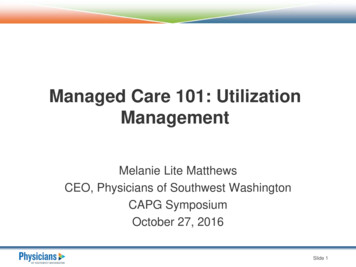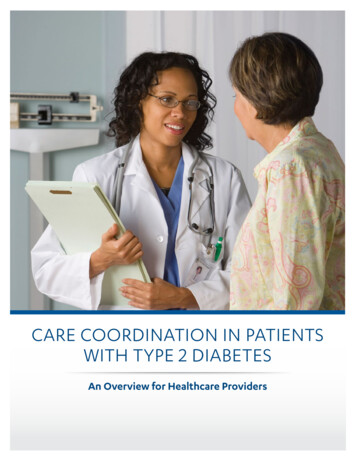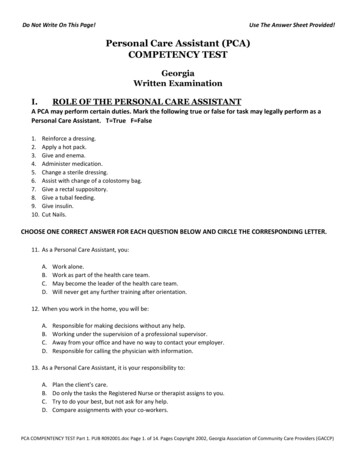
Transcription
Advancing Team-Based Care ThroughCollaborative Practice AgreementsA Resource and Implementation Guidefor Adding Pharmacists to the Care Team
Dear Pharmacists and Collaborating Prescribers:Nearly one in every three deaths in the United States is caused by cardiovascular disease (CVD).1Sixty percent of preventable heart disease and stroke deaths happen to people under age65.2 With the burden of chronic disease in the US increasing, we need new ways to empowerpatients and improve care. Pharmacists have long been identified as an underutilized publichealth resource.3 Pharmacists are well positioned to help fill the chronic disease managementgap and can make a difference when they are actively engaged as part of a team-basedcare approach.Collaborative practice agreements increase the efficiencies of team-based care and formalizepractice relationships between pharmacists and collaborating prescribers. For this reason,the National Alliance of State Pharmacy Associations (NASPA), American PharmacistsAssociation (APhA), American Medical Association (AMA), the American Association ofNurse Practitioners (AANP), the Network for Public Health Law – Eastern Region, andUniversity of Maryland Francis King Carey School of Law have collaborated with the Centersfor Disease Control and Prevention, Division for Heart Disease and Stroke Prevention, todevelop this guide, Advancing Team-Based Care through Collaborative Practice Agreements.The guide is a resource for pharmacists to use in developing and executing collaborativepractice agreements in the spirit of advancing team-based care. It provides a customizabletemplate that can be used as a starting point to developing a collaborative practice agreement.The collaborating organizations recognize the value of pharmacists as a necessary member ofthe patient care team and endorse use of this guide to form collaborative practice agreements.Together, we can work to improve the quality of patient care, better prevent and treat chronicdisease and improve population health.National Alliance of State Pharmacy Associations (NASPA)American Pharmacists Association (APhA)American Medical Association (AMA)American Association of Nurse Practitioners (AANP)Network for Public Health Law – Eastern RegionUniversity of Maryland Francis King Carey School of Law1 Centers for Disease Control and Prevention. National Statistics Report: Deaths: Final Data for 2014. 2016(June);65(4).Chamblee, GA: CDC, U.S. Department of Health and Human Services; 2016. Accessed December 19, 2016.2 Centers for Disease Control and Prevention. Vital Signs: Preventable Deaths from Heart Disease & Stroke. AccessedDecember 19, 2016.3 American Public Health Association. APHA policy 8024: The Role of the Pharmacist in Public Health. 1981; 71:213–6.American Journal of Public Health.
Executive SummaryRationaleinterpreting laboratory tests may also be included if thoseChronic diseases are the leading causes of death andservices are not already authorized in the pharmacist’sdisability in the United States, accounting for sevenregular scope of practice.of every ten deaths in this country. In 2014, one inevery three deaths was due to cardiovascular disease(CVD). One in three U.S. adults has high blood pressure,and almost half of these individuals do not have thiscondition under control. Team-based care results inpersonalized, timely, and empowered patient care—and it facilitates communication and coordinationamong team members. The evidence is strong thatwhen pharmacists are members of the health careteam, outcomes related to preventing or managingchronic disease (e.g., blood pressure, blood glucose,cholesterol, obesity, smoking cessation) and medicationadherence improve. The purpose of this guide is toempower community pharmacists and collaboratingprescribers to initiate collaborative practice agreements(CPAs) focused on caring for patients with chronicdiseases, including CVD.CPAs Support Team-Based CareCPAs are built upon a foundation of trust betweenpharmacists and prescribers and serve as a usefulmechanism for increasing efficiencies of team-basedcare. When designed correctly, CPAs are beneficial tothe collaborative delivery of care through delegationby the physician or other prescriber of specific patientcare services to pharmacists. This delegation canexpand available services to patients and increasecoordination of care. For example, the use of CPAs candecrease the number of requests to authorize refills,modify prescriptions, initiate therapeutic interchanges(in which the pharmacist can substitute another drugfor the medication prescribed), and order and interpretlaboratory tests, while keeping the prescriber apprisedof the pharmacist’s actions through establishedcommunication mechanisms. This allows each memberCollaborative Practice Agreementsof the health care team to complement the skillsCPAs create a formal practice relationship betweenand knowledge of the other members and morea pharmacist and a prescriber, who is most often aeffectively facilitate patient care, resulting in improvedphysician, although a growing number of states arepatient outcomes.allowing for CPAs between pharmacists and otherhealth professionals, such as nurse practitioners. Theagreement specifies what functions (in addition to thepharmacist’s typical scope of practice) can be delegatedto the pharmacist by the collaborating prescriber. Theterms used and the functions provided under a CPAvary from state to state based on the pharmacist’s andprescriber’s scope of practice and the state’s collaborativepractice laws. Most often, the functions delegated topharmacists by prescribers include initiating, modifying,or discontinuing medication therapy. Ordering andScope of Service and RequirementsMany pharmacists’ services do not require a CPA. Forexample, assessing medication therapy for drug-relatedproblems, performing hypertension and cholesterolscreenings, and educating patients are already withinpharmacists’ regular scope of practice. A CPA is notrequired for pharmacists or practitioners to collaboratein providing care. The only requirement is cooperationtoward achieving a common goal—providing optimalpatient care. While it is important to have shared goals,
clear roles, effective communication, and measurablethe prescriber’s patient population and the servicesprocesses and outcomes, the degree of trust withinprovided will help to facilitate the uptake of a CPA.the relationship is often the deciding factor for turningFinally, pharmacists can anticipate prescribers’ concernscollaborative relationships into contractual CPAs.related to delegating authority for care and be preparedBuilding trust is often a progressive process. Forto respond to those concerns in an effective manner.example, a collaborative relationship may begin withSteps to Implementationa pharmacist dispensing a prescriber’s prescription,A CPA template and sample language for eachfollowed by an exchange of medication information.component are included in this resource guide. TheThis advances to a prescriber accepting a pharmacist’simplementation of a CPA involves a series of stepsrecommendations for medication therapy, and thenthat depend on state laws and pharmacist-prescriberto a prescriber delegating disease managementpreferences. The implementation steps may includeresponsibilities and granting authority for medicationregistering the CPA with the board of pharmacy ortherapy management to a pharmacist under a formalsome other governing body, developing data sharingCPA. Trustworthiness, role specification, and professionaland business associate agreements, obtaininginteractions are three critical factors to establishing trusta pharmacist National Provider Identifier number,within a collaborative relationship.and identifying a business model that sustains theComponents of a CPA and Applicable Lawsagreed-upon scope of services.Pharmacists interested in pursuing CPAs withCPAs offer a unique opportunity for pharmacists toprescribers should seek to understand the laws oncollaborate with prescribers in the treatment andCPAs within their state, identify prescribers with whommanagement of chronic conditions, including CVD anda relationship already exists or build a relationshiphypertension. This guide offers resources to develop andwith prescribers with mutual interests, and considerimplement a CPA between pharmacists and prescribersoffering basic services (e.g., refill authorizations,for the purpose of advancing public health and improvingtherapeutic interchange) as an initial step. Seekingpatient outcomes, quality and process measures, efficacy,to identify and understand the prescriber’s unmetand patient and provider satisfaction.needs and demonstrating competency as it relates toA formal CPA can have many components including the following:Scope of AgreementLegal ComponentsAdministrative Components Parties to the agreement Patient inclusion criteria Patient care functions authorized Authority and purposeLiability insuranceInformed consent of the patientReview of the agreement andmaximum period of validity Rescindment or alterationof agreement Signatures of the parties tothe agreement Training and educationDocumentationCommunicationQuality assurance (or qualitymeasurement) Retention of records
AcknowledgmentsDisclaimerThe Division for Heart Disease and Stroke PreventionWebsite addresses of nonfederal organizations arewithin the Centers for Disease Control and Preventionprovided solely as a service to our readers. Provision ofin collaboration with ChangeLab Solutions, the Nationalan address does not constitute an endorsement by theAlliance of State Pharmacy Associations, the AmericanCenters for Disease Control and Prevention (CDC) or thePharmacists Association, the Network for Public Healthfederal government, and none should be inferred. CDCLaw – Eastern Region, and the University of Marylandis not responsible for the content of other organizations’Francis King Carey School of Law developed this guide.web pages.Contributions to the development and review of thisThe information contained in this document does notguide were made by Jeffrey M. Durthaler, BSPharm, MS,constitute legal advice. Use of any provision hereinand Siobhan Gilchrist, JD, MPH, (IHRC, Inc.); Elizabethshould be contemplated only in conjunction withNelson, BA, Rebecca Snead, BSPharm, and Krystalynadvice from legal counsel. Provisions may need toWeaver, PharmD, (National Alliance of State Pharmacybe modified, supplemented, or replaced to ensureAssociations); Megan Griest, JD, MPP, and Kathleenappropriate citation to or compliance with relevantHoke, JD, (University of Maryland Francis King Careylaws, to accurately reflect the intent of the parties toSchool of Law); Anne Burns, BSPharm, Lindsay Kunkle,a particular agreement, or to otherwise address thePharmD, and Stacia Spridgen, PharmD, (Americanneeds or requirements of a specific jurisdiction.Pharmacists Association); Kathleen Heneghan, MPH,DrPH candidate, and Michael Rakotz, MD, (AmericanMedical Association); Taynin Kopanos, DNP, NP, andBrittany Dawn McAllister, MPH, (American Association ofNurse Practitioners).Suggested CitationCenters for Disease Control and Prevention. AdvancingTeam-Based Care Through Collaborative PracticeAgreements: A Resource and Implementation Guidefor Adding Pharmacists to the Care Team. Atlanta, GA:Centers for Disease Control and Prevention, U.S.Department of Health and Human Services; 2017.Financial Disclosure/FundingThis publication was supported by the CooperativeAgreement Number 5U38OT000141-03 awarded toChangeLab Solutions from the Centers for DiseaseControl and Prevention.
ContentsOverview .5Impact of Chronic Disease. 5Value of Pharmacists’ Patient Care Services . 5Advancing Pharmacists in Team-Based Carear . 6Purpose and Development Process . 6About Collaborative Practice Agreements .7Definition of a CPA . 7Using CPAs to Facilitate Team-Based Patient Care . 7Terminology. 8States Permitting CPAs . 8Finding the Applicable State Laws and Regulations. 8Pharmacy Services Under CPAs . 8Collaborative Care as a Basis for CPAs . 10Developing the Relationship and Building Trust . 10Formalizing Collaborative Relationships Through CPAs. 11Identifying Partners . 11Initiating the Relationship. 12Adapting a Template CPA for a Hypertension andCardiovascular Disease Service . 14A. Authority and Purpose . 17B. Parties to the Agreement . 17D. Patient Care Functions Authorized . 18E. Training/Education . 19F. Liability Insurance . 19G. Informed Consent of the Patient . 19H. Documentation . 19I. Communication. 21K. Review of the Agreement and Maximum Period of Validity . 22M. Rescindment or Amendment of Agreement . 22N. References. 23O. Signatures of the Parties to the Agreement . 23Facilitating the Use of CPAs: Other Considerations. 24Registering With State Agencies. 24Data Sharing and Business Associate’s Agreements . 24Sustainability of Pharmacists’ Patient Care Services. 24Pharmacist’s National Provider Identifier Number. 24Conclusion . 25References. 26Appendix A: Collaborative Practice Agreement Authority Tables . 28Appendix B: Sustainability of Pharmacists’ Services DeliveredUnder Collaborative Practice Agreements . 34Appendix C: Updating a National Provider Identifier Number . 40
OverviewImpact of Chronic Diseasepersonalized, timely, and empowered patient care andChronic diseases are the leading causes of death andfacilitates communication and coordination amongdisability in the United States, accounting for seventeam members.of every ten deaths. In 2012, 117 million Americans1(about half of the adult population) had at least onechronic illness.2 An estimated 25% of U.S. adults withchronic conditions have one or more limitations in dailyactivities.2 In 2014, one in every three deaths was due tocardiovascular disease (CVD).3,4In 1981, the American Public Health Associationdeclared that pharmacists were an underutilizedresource in promoting public health. Since then,several public health needs—such as public access toimmunizations—have been addressed by communitypharmacists. One of the reasons that pharmacists canHypertension, hyperlipidemia, and smoking are keyaddress emerging public health needs is that they arerisk factors for CVD, and 47% of Americans have atamong the most accessible health care professionalsleast one of these three risk factors.5 One in threein the United States. Notably, an estimated 86% of theU.S. adults has high blood pressure, and almostU.S. population lives within 5 miles of a communityhalf of these individuals do not have this conditionpharmacy.14 While examples of pharmacists practicingunder control.5 Another 11.5 million of these adultsin team-based environments exist, there remains anare neither aware of their hypertension nor takingopportunity to increase and accelerate the inclusion ofantihypertensive medications. In addition, only onepharmacists as part of the patient care team.3,5third of people with high cholesterol have adequatecontrol of their hyperlipidemia, and 17% of U.S. adultssmoke cigarettes.6,7,8 Improved control of the risk factorsfor CVD requires an expanded effort from health caresystems and health care professionals in the healthsystem, including pharmacists.6Value of Pharmacists’ Patient Care ServicesIn 2011, the chief pharmacist officer of the U.S. PublicHealth Service authored a report, titled ImprovingPatient and Health System Outcomes Through AdvancedPharmacy Practice, to the U.S. surgeon general.15 Thisreport highlighted the efficacy of pharmacists inadvanced practice roles and advocated for intensifiedutilization of pharmacists in alleviating our nation’sInterventions to manage and control hypertension andimminent primary care provider crisis. The findings ofother risk factors for CVD can focus on removing healththe report were promptly endorsed and supportedcare professional- and patient-related barriers.by the 18th surgeon general, Vice Admiral Dr. ReginaA team-based model organizes care around patientBenjamin, who recommended that health leadershipneeds and commonly involves systems that supportand policy makers optimize the pharmacist’s role.16 Viceclinical decision making through collaborationsAdmiral Benjamin recommended that this be donebetween health care professionals or between thesethrough implementation of collaborative practiceprofessionals and their patients. There is strongmodels; recognition of pharmacists as providers,evidence that when pharmacists are part of the healthclinicians, and essential members of the health carecare team, outcomes related to preventing or managingteam; and exploration of additional compensationchronic diseases (e.g., blood pressure, blood glucose,models to support pharmacists in these expanded roles.9,10,11cholesterol, obesity, smoking cessation) and adherenceto medication improve.12,13 Team-based care results in
Advancing Pharmacists in Team-Based Care Collaborative Drug Therapy Management: CaseThe Centers for Disease Control and Prevention (CDC)Studies of Three Community-Based Models ofrecognizes the role of pharmacists in team-based careCare.20 This resource illustrates how CPAs havefor chronic disease management. The CDC Divisionbeen successfully implemented in three pharmacyfor Heart Disease and Stroke Prevention has createdpractice settings.resources to encourage pharmacists and prescribers(physicians and others who prescribe drugs) to workcollaboratively and formalize those relationshipsthrough collaborative practice agreements (CPAs), whenpossible. These resources include: A Program Guide for Public Health: PartneringPurpose and Development ProcessThe purpose of this resource guide is to empowercommunity pharmacists and collaborating prescribersto initiate CPAs that are focused on caring for patientswith chronic diseases. CVD and its risk factors are usedas an example throughout the resource guide. Thewith Pharmacists in the Prevention and Control ofprimary audience is pharmacists practicing in statesChronic Diseases. This resource provides exampleswhere existing regulations permit them to engageof how pharmacists can work within the four publicin CPAs for the monitoring and management ofhealth domains (i.e., environmental approaches,chronic disease.health systems, community-clinical linkages, andepidemiology and surveillance) to have a positiveeffect on patient health outcomes.17The information contained in this resource guide wascollected in these four ways: (1) reviewing existingliterature and resources; (2) analyzing laws and How Pharmacists Can Improve Our Nation’s Health.regulations on collaborative practice; (3) reviewingThis resource (a CDC Public Health Grand Roundsexamples of CPAs currently in use; and (4) holdingpresentation) provides examples of the roles thatroundtable meetings with pharmacists, physicians,pharmacists can play in team-based care.18public health professionals, academicians, and payer Collaborative Practice Agreements andPharmacists’ Patient Care Services. This resourceprovides an overview of CPAs.19representatives in five states (i.e., Kentucky, Minnesota,Tennessee, Washington, and Wisconsin).
CPA-related TerminologyOther terms for a CPA include: Collaborative pharmacy practice agreement. Collaborative care agreement. Consult agreement. Physician-pharmacist agreement. Standing order or protocol. Delegation of authority by physician.Terms used to describe the services providedunder a CPA include: Collaborative drug therapy management. Drug therapy management. Pharmaceutical care. Medication therapy services. Collaborative pharmacy practice.22About Collaborative Practice AgreementsDefinition of a CPACPAs create a formal practice relationship betweenUsing CPAs to Facilitate Team-BasedPatient Care22a pharmacist and a prescriber. The agreement specifiesWhen trust has been established, CPAs are a useful waywhat functions—in addition to the pharmacist’sto increase the efficiency of team-based care. Whentypical scope of practice—are delegated to thedesigned correctly, CPAs benefit the collaborativepharmacist by the collaborating prescriber. Thedelivery of care by delegating specific patient carecollaborating prescriber is most often a physician,services to pharmacists. This delegation can expandbut a growing number of states are allowing for CPAsavailable services to patients and increase thebetween pharmacists and nurse practitioners or otherefficiency and coordination of care. For example, CPAsnonphysicians. This resource guide uses the termcan decrease the number of phone calls required to“prescriber” to reference the collaborating provider whoauthorize refills or modify prescriptions, thus allowingis delegating patient care services to the pharmacisteach member of the health care team to complementunder the CPA.the skills and knowledge of the other member(s) andThe functions provided under the agreement varyfrom state to state based on the pharmacist’s scope ofpractice and the state’s collaborative practice laws.21Most often, CPAs are used in the context of authorizingpharmacists to initiate, modify, or discontinuemedication therapy. Functions performed under a CPAmay also include ordering and interpreting laboratorytests if those services are not already authorized in thepharmacist’s scope of practice.more effectively facilitate patient care, resulting inimproved patient outcomes.TerminologyThis resource guide uses the term “collaborative practiceagreement,” “collaborative agreement,” or “CPA” todescribe a practice relationship in which a prescriberdelegates selected patient care services to a pharmacist.The terminology used to describe this authority variesamong states as do the terms used to describe theservices provided under a CPA.
States Permitting CPAsPharmacy Services Under CPAsAs of May 2016, 48 states permit some type ofA variety of pharmacist-provided services can bepharmacist-prescriber collaborative practice authority.performed under a CPA. CVD-related services areHowever, some of these states’ laws and regulationsused as examples below to illustrate how pharmacistsmay not support the implementation of a CPA. Formay define pharmacy services within a CPA. Becauseexample, in Alabama and Delaware, prescribers cannotof variations in state laws, some of the services maydelegate authority to pharmacists via a CPA, and inbe permitted under a pharmacist’s regular scope ofFlorida and Oklahoma, pharmacists are restricted topractice in some states but represent an expansion ofproviding only limited services under a CPA.practice in others.State laws for CPAs vary widely; the key variables inAuthorization of refills. In this service, the prescriberthese laws are below. Thus, the terms of the written CPAauthorizes the pharmacist to extend refills based on thewill need to be customized to the laws and regulationspharmacist’s assessment (e.g., using the pharmacists’of a given state.patient care process) of the patient. For example, underFinding the Applicable State Lawsand RegulationsBefore entering into a CPA, pharmacists and prescribersmay benefit by reviewing their state’s current laws andregulations pertaining to CPAs. Appendix A containsCPA laws for each state (as of December 31, 2015). Stateboards of pharmacy and medicine and state pharmacythe terms of a CPA, a pharmacist may be permittedto extend refills of a patient’s medications for treatingchronic hypertension and hypercholesterolemia, therebyremoving delays in therapy and administrative barriersand potentially increasing medication adherence.Without a CPA, in most states, pharmacists would need tocontact the prescriber to obtain authorization for a refill.and medical associations can serve as points of contactfor the most up-to-date information on CPA authority.To obtain access to a specific state’s current pharmacylaws and regulations, visit the National Association ofBoards of Pharmacy website.Variables in State CPA Laws and RegulationsCPA Participants Number of pharmacists. Number of prescribers. Number of patients. Types of prescribers. Relationship between patientand prescriber. Pharmacist-to-prescriber ratio.Authorized Functions Modify medication therapy. Initiate medication therapy. Discontinue medication therapy. Conduct physical assessment. Order laboratory studies. Interpret laboratory studies. Perform laboratory tests.Requirements and Restrictions Continuing education. Qualifications of pharmacist. Liability insurance. Disease state of patient. Practice setting. Medications to be managed. Involvement of patient. Agreements approved or reported,and to which entity. Length of time that agreement is valid. Documentation. Communications. Review by physician.
Therapeutic interchange. Here the prescriberrecommendation to the prescriber. The prescriber wouldauthorizes the pharmacist, under a CPA, to substitutethen have to act on the recommendation in order foranother drug in the same drug class (e.g., angiotensin-the pharmacist to make a change in therapy. The CPAconverting enzyme inhibitors to treat hypertension)leverages the pharmacist’s medication andfor the medication originally prescribed. This usuallyhealth-related expertise to extend the care of thehappens because of the variability in a particular healthprescriber’s patients while coordinating care withplan’s formulary of accepted drugs. The pharmacist’sthe prescriber.clinical knowledge of medications informs his or herOrdering laboratory tests.choice of medication within a particular class of drugs.Hypertension management. In this service, theHere the CPA may authorize the pharmacist to orderand interpret laboratory tests that are essential forprescriber authorizes the pharmacist to initiate, modify,effectively monitoring medications or the statusor discontinue medications. For example, under theof chronic conditions. For example, as part of aterms of a CPA, a pharmacist may be permitted to addhypertension CPA, the pharmacist could order urinetherapies if the patient’s hypertension is uncontrolled,and blood analyses to test for electrolyte levels, fluidadjust doses of medication, or discontinue medicationsbalance, and kidney function.that are not working or cause side effects. TheNote that some pharmacists’ CVD-related services, suchmedications or medication classes that pharmacistsare permitted to initiate, modify, or discontinue maybe indicated in the agreement. Without the CPA, thepharmacist would have to assess the patient and make aState Scope of Practice & CPAsThe patient care functions that pharmacists are authorizedto perform with and without a CPA are highly variable fromstate to state. A function that a pharmacist can perform onlyif authorized under a CPA in one st
practice laws. Most often, the functions delegated to pharmacists by prescribers include initiating, modifying, or discontinuing medication therapy. Ordering and interpreting laboratory tests may also be included if those services are not already authorized in the pharmacist's regular scope of practice. CPAs Support Team-Based Care










